Food Truck Market Size
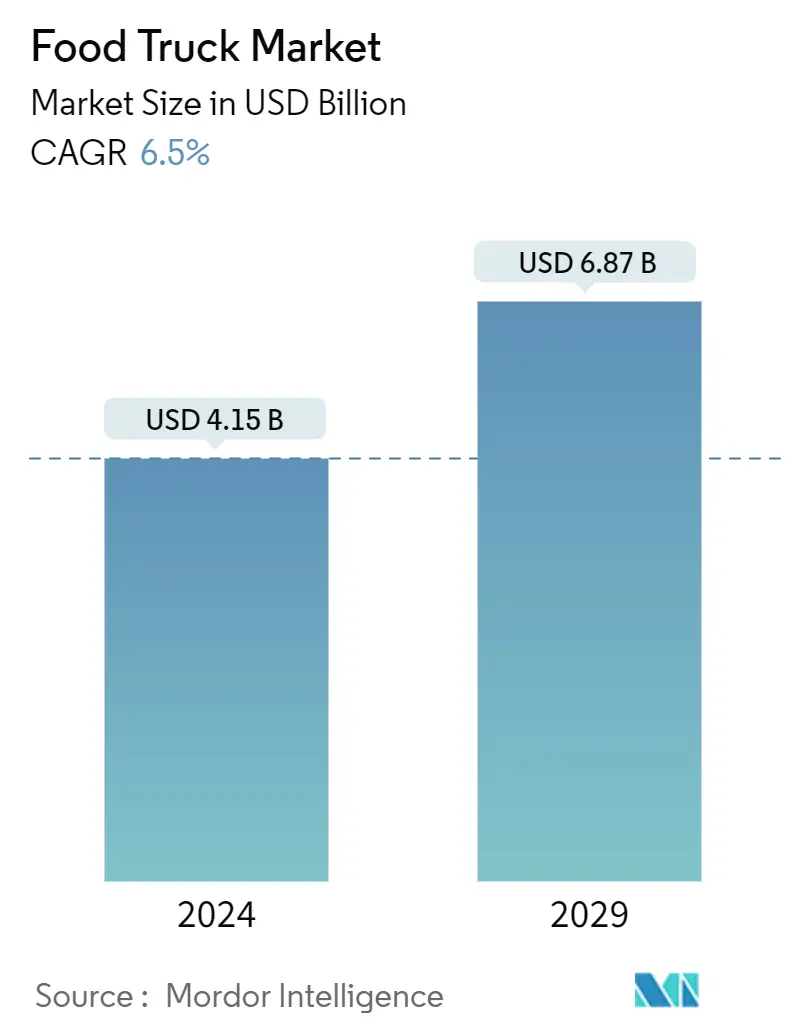
| Study Period | 2019 - 2029 |
| Market Size (2024) | USD 4.15 Billion |
| Market Size (2029) | USD 6.87 Billion |
| CAGR (2024 - 2029) | 6.50 % |
| Fastest Growing Market | North America |
| Largest Market | North America |
Major Players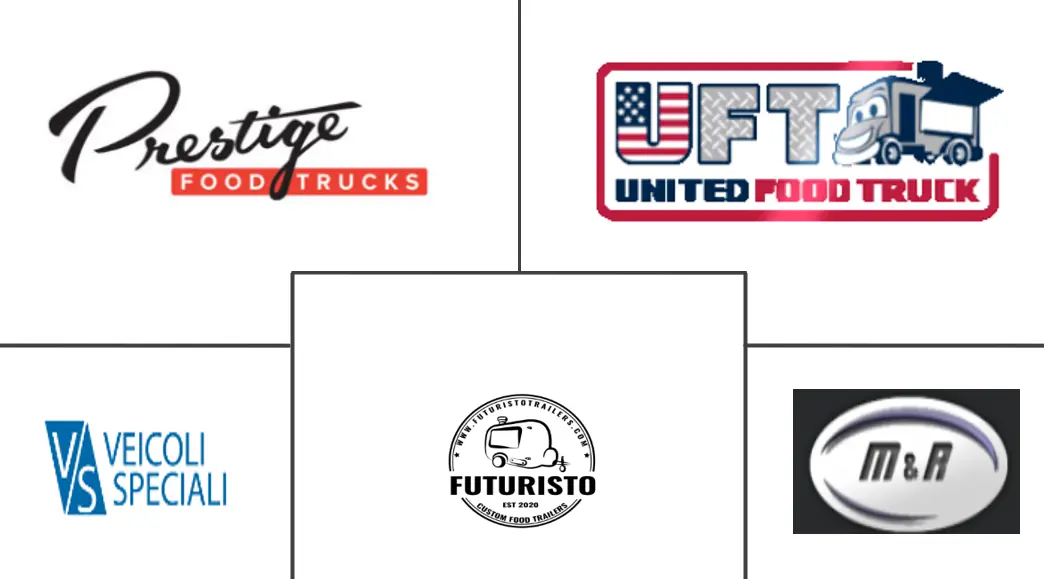
*Disclaimer: Major Players sorted in no particular order |
Need a report that reflects how COVID-19 has impacted this market and its growth?
Food Truck Market Analysis
The Food Truck Market size is estimated at USD 4.15 billion in 2024, and is expected to reach USD 6.87 billion by 2029, growing at a CAGR of 6.5% during the forecast period (2024-2029).
The food truck market has experienced substantial growth over the past decade, emerging as a dynamic and integral part of the broader foodservice industry. This industry, characterized by its mobility, flexibility, and unique culinary offerings, has evolved from a fringe novelty into a mainstream foodservice phenomenon. Technology plays a crucial role in the evolution and success of the food truck market. Modern food trucks are equipped with advanced kitchen equipment that enhances their ability to efficiently prepare a wide range of dishes. Moreover, the integration of point-of-sale (POS) systems and mobile payment solutions has streamlined the transaction process, making it easier for customers to order and pay for their meals.
Social media and digital marketing are also pivotal in promoting and growing food trucks. Platforms like Instagram, Facebook, and Twitter are extensively used by food truck operators to engage with customers, announce locations, promote menu items, and build a loyal following. This digital presence increases visibility and fosters a sense of community and direct interaction with customers.
While the food truck market offers numerous opportunities, it also faces regulatory challenges that vary significantly by region. Local governments impose regulations on food safety, health standards, parking permits, operating hours, and zoning laws. Compliance with these regulations is essential for food truck operators, but navigating the complex and often inconsistent regulatory landscape can be challenging.
The food truck market is highly competitive, with numerous operators vying for customer attention. Successful food truck businesses often differentiate themselves through unique branding, high-quality food, exceptional customer service, and strategic location choices. Collaboration with local businesses and participation in food truck festivals and community events can also enhance visibility and customer engagement.
The COVID-19 pandemic had a mixed impact on the food truck market. While some operators faced significant challenges due to lockdowns, reduced foot traffic, and event cancellations, others adapted by leveraging their mobility and outdoor service model to continue operating. The pandemic accelerated the adoption of contactless payment systems and online ordering, which have now become standard practices in the industry.
Food trucks also played a crucial role in supporting communities during the pandemic by providing accessible and convenient dining options when traditional restaurants were closed or limited in capacity. This resilience and adaptability reinforced the food truck market's position as a vital component of the foodservice industry.
The food truck market has evolved into a dynamic and integral segment of the foodservice industry, characterized by its flexibility, innovation, and adaptability. The combination of changing consumer preferences, technological advancements, and economic advantages continues to drive growth and diversification in the market.
Food Truck Market Trends
Fast Food is Driving Market Growth
The food truck market has grown impressively over the past decade, and a significant driver of this expansion has been the fast food segment. Fast food’s inherent qualities, such as convenience, affordability, and speed, align perfectly with the food truck business model, creating a synergy that propels both industries forward.
The convenience factor is perhaps the most significant advantage of food trucks in the fast food industry. Consumers today lead busy lives, and the demand for quick, accessible meals is at an all-time high. By their very nature, food trucks offer mobility, allowing them to reach customers where they are, outside office buildings, at parks, or at popular events. This mobility is a key selling point for fast food offerings, which thrive on providing quick, on-the-go meals. Unlike traditional brick-and-mortar fast food restaurants, food trucks can relocate based on demand, ensuring a steady stream of customers.
The relatively low start-up and operational costs of food trucks compared to traditional restaurants make them an attractive venture for entrepreneurs. The fast food model, which typically requires less expensive ingredients and faster turnover, fits well within the food truck framework. Entrepreneurs can enter the market with a smaller investment, minimizing financial risk. This economic advantage has led to a proliferation of food trucks offering various fast food options, from burgers and tacos to sandwiches and pizza.
Moreover, consumer preferences are evolving, with a growing emphasis on unique and high-quality dining experiences. Food trucks have capitalized on this trend by offering gourmet fast food options that stand out from traditional fast food chains. These trucks often experiment with fusion cuisines, artisanal ingredients, and innovative recipes, attracting food enthusiasts looking for something different. This blend of quality and convenience has helped food trucks carve out a niche in the fast food segment.
The combination of changing consumer preferences, technological advancements, and economic advantages continues to drive the expansion of fast food trucks.
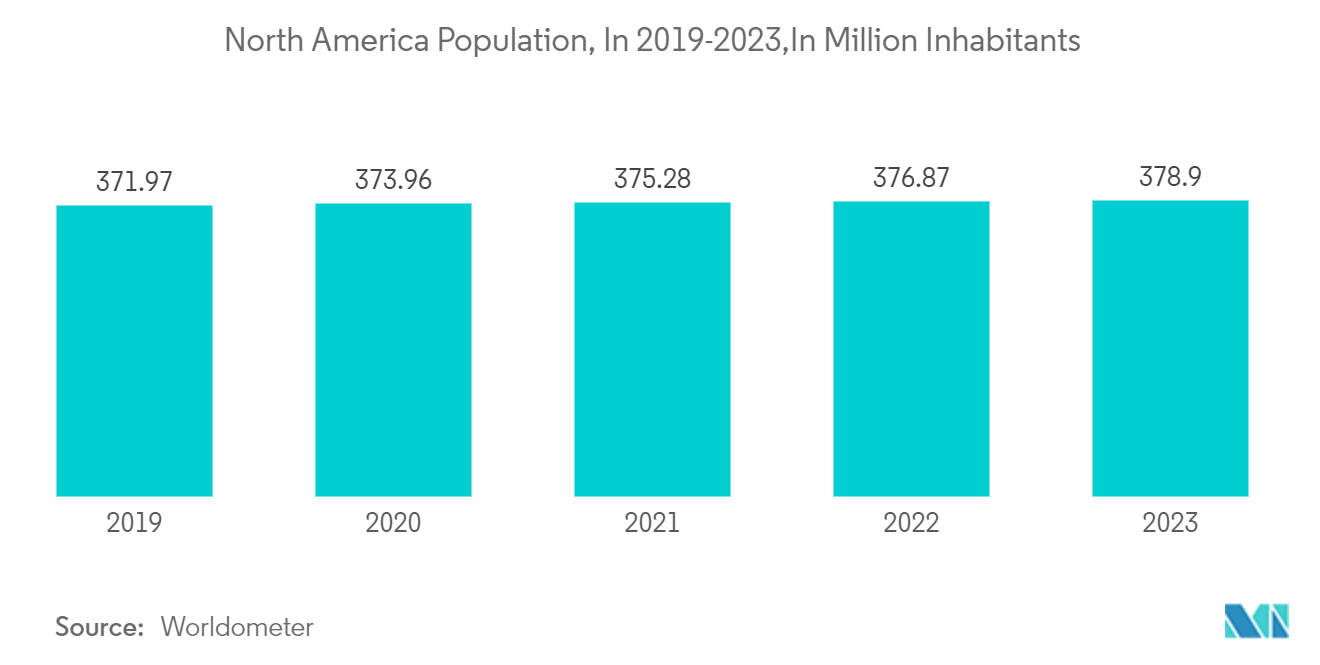
North America and Europe Witnessing Major Growth
The food truck market has been experiencing substantial growth globally, with North America and Europe emerging as significant regions driving this expansion. In North America and Europe, consumer preferences are shifting toward unique, high-quality, and convenient dining experiences. There is a growing demand for diverse culinary offerings in both regions that traditional restaurants may not provide. Food trucks cater to this demand by offering innovative and eclectic menus, often featuring gourmet, ethnic, and fusion cuisines.
Economic considerations also play a crucial role in the growth of the food truck market. The relatively low start-up and operational costs of food trucks compared to traditional brick-and-mortar restaurants make them an attractive venture for entrepreneurs. Initial investments for a food truck business are significantly lower, often ranging between USD 50,000 and USD 200,000. This affordability allows more entrepreneurs to enter the market, contributing to the proliferation of food trucks across cities in North America and Europe.
The regulatory environment in North America and Europe has become increasingly supportive of the food truck industry. Local governments in many cities have recognized the economic and cultural benefits of food trucks and are working to create more favorable regulatory frameworks. This includes streamlining the permit process, designating specific areas for food truck operations, and providing clear guidelines on health and safety standards.
In North America, cities like Los Angeles, New York, and Austin have established comprehensive regulations that support the growth of the food truck market. Similarly, in Europe, cities like London, Berlin, and Paris have seen an increase in food truck-friendly policies, which has contributed to the market's growth.
As the market continues to evolve, food truck operators in North America and Europe are likely to benefit from ongoing trends such as sustainability, technology integration, and health-conscious dining. The competitive landscape will drive continuous innovation, ensuring that consumers have access to a diverse and exciting array of food options. With their resilience and adaptability, food trucks are well-positioned to thrive in the dynamic and ever-changing foodservice industry, making North America and Europe key regions in the global food truck market.
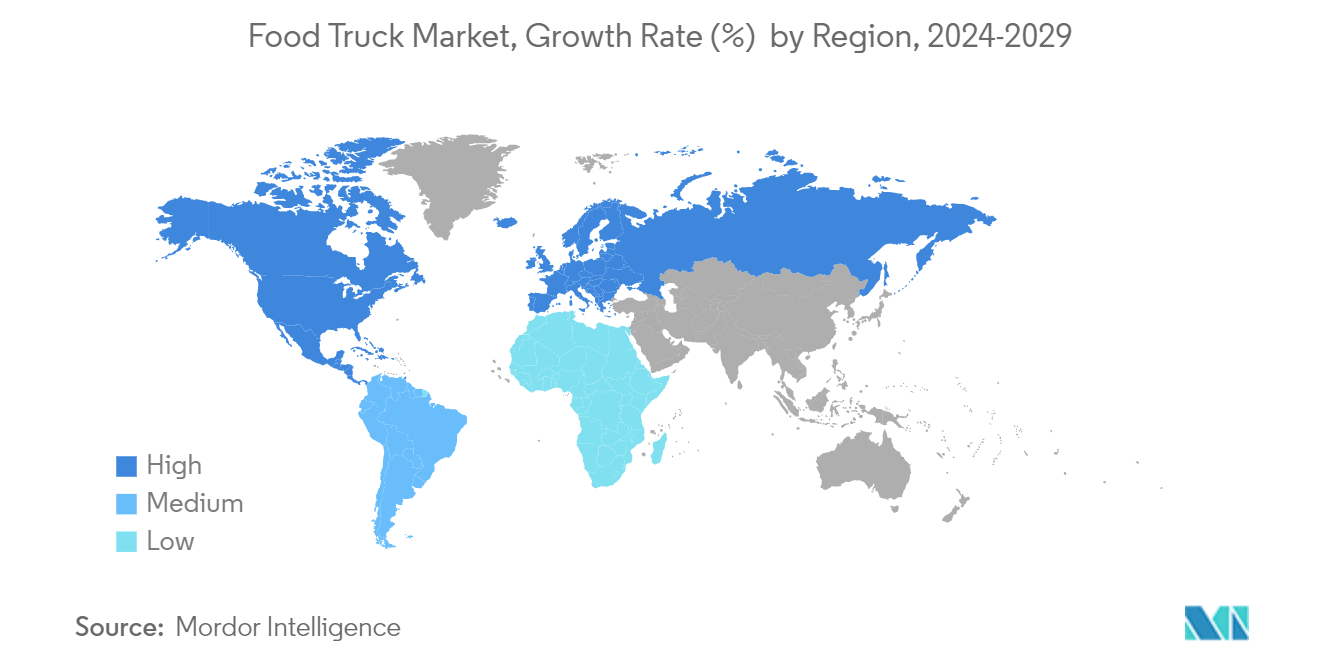
Food Truck Industry Segmentation
The food truck market is dominated by several key players, such as Prestige Food Trucks, United Food Trucks United LLC, and M&R Specialty Trailers and Trucks. Major players in this industry are focusing on technological advancements. These companies focus on innovation and technological advancements to enhance the functionality and appeal of their food trucks. For example, they invest in state-of-the-art kitchen equipment, advanced POS systems, and eco-friendly technologies to meet evolving consumer demands and regulatory requirements.
Food Truck Market Leaders
-
Prestige Food Trucks
-
United Food Trucks United, LLC
-
VS VEICOLI SPECIALI
-
Futuristo Trailers
-
M&R SPECIALTY TRAILERS AND TRUCKS
*Disclaimer: Major Players sorted in no particular order
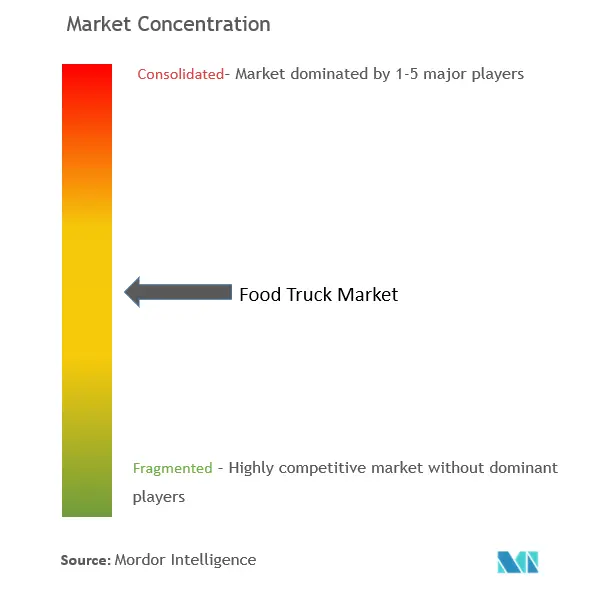
Food Truck Market News
- June 2023: Volta Trucks partnered with METRO Germany, a major international food wholesaler. The 16-tonne all-electric Volta Zero will be deployed for METRO in North Rhine-Westphalia. As more vehicles join the fleet, it will be expanded to Bavaria and Berlin. METRO Germany plans to expand its delivery fleet sustainably.
- June 2023: Hyzon Motors Inc. and Performance Food Group Inc. (PFG), one of North America's largest food and foodservice distribution companies, announced an agreement for five fuel-cell electric vehicles (FCEV).
- April 2023: Toyota Australia brought the FCV Express Diner, an innovative fuel cell food truck concept, to a national Hydrogen Showcase in Melbourne, demonstrating various potential applications for its hydrogen fuel cell technology. The HiAce-based FCV Express Diner concept, a Caetano 33-seat commercial bus, a Toyota forklift, an EODev stationary power generator, and the Toyota Mirai FCV sedan were among Toyota’s fuel cell vehicles on display.
Food Truck Market Report - Table of Contents
1. INTRODUCTION
- 1.1 Study Assumptions
- 1.2 Scope of the Study
2. RESEARCH METHODOLOGY
3. EXECUTIVE SUMMARY
4. MARKET DYNAMICS
-
4.1 Market Drivers
- 4.1.1 Increasing Consumption of Fast Food Expected to Drive the Market
-
4.2 Market Restraints
- 4.2.1 Increase in Online Food Deliveries May Hamper Market Growth
-
4.3 Porter's Five Forces Analysis
- 4.3.1 Bargaining Power of Suppliers
- 4.3.2 Bargaining Power of Buyers/Consumers
- 4.3.3 Threat of New Entrants
- 4.3.4 Threat of Substitute Products
- 4.3.5 Intensity of Competitive Rivalry
5. MARKET SEGMENTATION (Market Size by Value - USD)
-
5.1 Type
- 5.1.1 Vans
- 5.1.2 Trailers
- 5.1.3 Trucks
- 5.1.4 Other Types
-
5.2 Size
- 5.2.1 Up to 14 Feet
- 5.2.2 Above 14 Feet
-
5.3 By Application Type
- 5.3.1 Fast Food
- 5.3.2 Vegan and Meat Plant
- 5.3.3 Bakery
- 5.3.4 Other Applications
-
5.4 Geography
- 5.4.1 North America
- 5.4.1.1 United States Of America
- 5.4.1.2 Canada
- 5.4.1.3 Mexico
- 5.4.1.4 Rest of North America
- 5.4.2 Europe
- 5.4.2.1 Germany
- 5.4.2.2 United Kingdom
- 5.4.2.3 France
- 5.4.2.4 Italy
- 5.4.2.5 Spain
- 5.4.2.6 Rest of Europe
- 5.4.3 Asia-Pacific
- 5.4.3.1 India
- 5.4.3.2 China
- 5.4.3.3 Japan
- 5.4.3.4 South Korea
- 5.4.3.5 Rest of Asia-Pacific
- 5.4.4 Rest of the World
- 5.4.4.1 Brazil
- 5.4.4.2 Saudi Arabia
- 5.4.4.3 United Arab Emirates
- 5.4.4.4 South Africa
6. COMPETITIVE LANDSCAPE
- 6.1 Vendor Market Share
-
6.2 Company Profiles*
- 6.2.1 Prestige Food Trucks
- 6.2.2 United Food Trucks United LLC
- 6.2.3 VS VEICOLI SPECIALI
- 6.2.4 Futuristo Trailers
- 6.2.5 M&R Specialty Trailers and Trucks
- 6.2.6 MSM Catering Manufacturing Inc.
- 6.2.7 The Fud Trailer Company
- 6.2.8 Food Truck Company BV
- 6.2.9 Foodtrucker Engineering LLP
7. MARKET OPPORTUNITIES AND FUTURE TRENDS
** Subject To AvailablityFood Truck Industry Segmentation
A food truck is a motorized vehicle, such as a van or trailer, from which food is sold. It typically contains cooking facilities where the food is prepared.
The food truck market is segmented by type, size, application, and geography. On the basis of type, the market is segmented into vans, trailers, trucks, and other types. By size, the market is segmented into up to 14 feet and above 14 feet. By application, the market is segmented into fast food, vegan and meat plant, bakery, and other applications. By geography, the market is segmented into North America, Europe, Asia-Pacific, and the Rest of the World. The report offers the market sizes and forecasts for all the above segments in terms of value (USD).
| Type | Vans | |
| Trailers | ||
| Trucks | ||
| Other Types | ||
| Size | Up to 14 Feet | |
| Above 14 Feet | ||
| By Application Type | Fast Food | |
| Vegan and Meat Plant | ||
| Bakery | ||
| Other Applications | ||
| Geography | North America | United States Of America |
| Canada | ||
| Mexico | ||
| Rest of North America | ||
| Geography | Europe | Germany |
| United Kingdom | ||
| France | ||
| Italy | ||
| Spain | ||
| Rest of Europe | ||
| Geography | Asia-Pacific | India |
| China | ||
| Japan | ||
| South Korea | ||
| Rest of Asia-Pacific | ||
| Geography | Rest of the World | Brazil |
| Saudi Arabia | ||
| United Arab Emirates | ||
| South Africa |
Food Truck Market Research FAQs
How big is the Food Truck Market?
The Food Truck Market size is expected to reach USD 4.15 billion in 2024 and grow at a CAGR of 6.5% to reach USD 6.87 billion by 2029.
What is the current Food Truck Market size?
In 2024, the Food Truck Market size is expected to reach USD 4.15 billion.
Who are the key players in Food Truck Market?
Prestige Food Trucks, United Food Trucks United, LLC, VS VEICOLI SPECIALI, Futuristo Trailers and M&R SPECIALTY TRAILERS AND TRUCKS are the major companies operating in the Food Truck Market.
Which is the fastest growing region in Food Truck Market?
North America is estimated to grow at the highest CAGR over the forecast period (2024-2029).
Which region has the biggest share in Food Truck Market?
In 2024, the North America accounts for the largest market share in Food Truck Market.
What years does this Food Truck Market cover, and what was the market size in 2023?
In 2023, the Food Truck Market size was estimated at USD 3.88 billion. The report covers the Food Truck Market historical market size for years: 2019, 2020, 2021, 2022 and 2023. The report also forecasts the Food Truck Market size for years: 2024, 2025, 2026, 2027, 2028 and 2029.
What are the key driving factors for the Food Truck Market?
The major factors driving the Food Truck Market are the increasing consumption of fast food and the rising trend of urbanization.
What are the key driving factors for the Food Truck Market?
The major factors driving the Food Truck Market are the increasing consumption of fast food and the rising trend of urbanization.
Food Trucks Industry Report
The global food truck market is segmented by type, size, application, and geography. The market size and market forecast are provided in terms of value for all segments. The industry statistics indicate that the market is experiencing growth due to a surge in gastronomy and the rising preference of consumers for unique meal experiences over traditional restaurant experiences. This market growth is attributed to consumers' increasing inclination towards gourmet offerings and unique food concepts, the lower cost and quicker permit acquisition for starting a food truck business compared to a brick-and-mortar restaurant, and the launch of food trucks by established commercial restaurant chains at prime locations.
Buses and vans hold the largest revenue share due to their easy mobility and lower costs, with the medium-sized food trucks segment accounting for the maximum share of the overall revenue. However, the small size segment is projected to register the fastest growth rate. While the fast-food segment made the largest contribution to the global market, the vegan & meat plant segment is expected to grow at the fastest rate. Europe holds the largest revenue share of the global market, but Asia Pacific is expected to witness the fastest growth rate.
The industry reports provide comprehensive industry analysis, including industry information and industry trends. The market overview highlights the market segmentation and market value, offering insights into the market outlook and market predictions. The report pdf includes detailed industry research and market review, with contributions from research companies. The industry outlook and market data are essential for understanding the industry's current state and future market leaders. The market forecast and market predictions are crucial for stakeholders to make informed decisions. The report example and report pdf serve as valuable resources for those seeking in-depth industry analysis.

